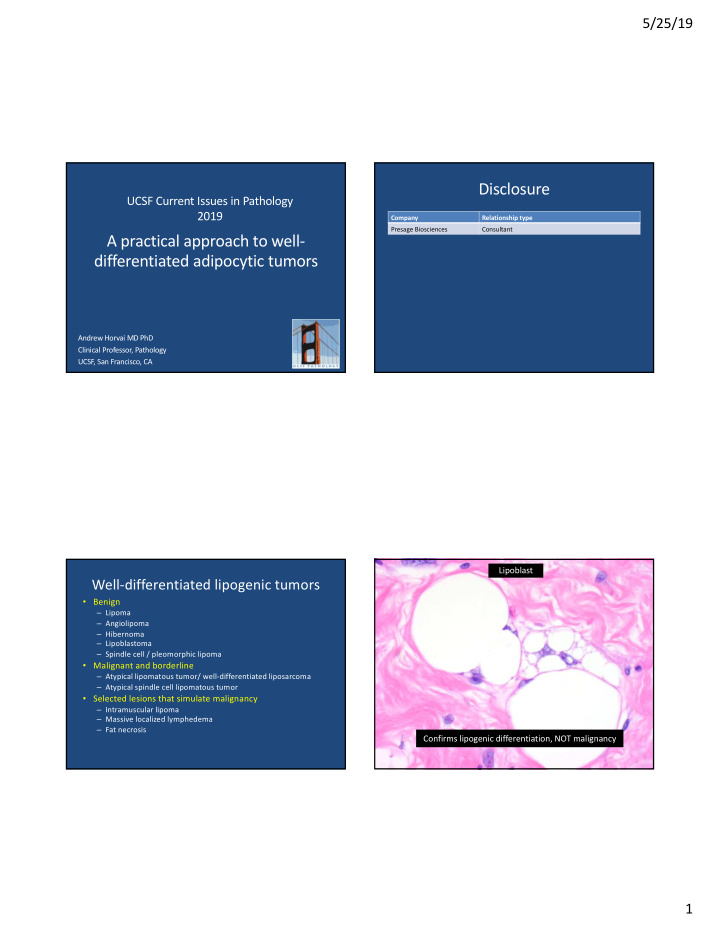



5/25/19 Disclosure UCSF Current Issues in Pathology 2019 Company Relationship type Presage Biosciences Consultant A practical approach to well- differentiated adipocytic tumors Andrew Horvai MD PhD Clinical Professor, Pathology UCSF, San Francisco, CA Lipoblast Well-differentiated lipogenic tumors • Benign – Lipoma – Angiolipoma – Hibernoma – Lipoblastoma – Spindle cell / pleomorphic lipoma • Malignant and borderline – Atypical lipomatous tumor/ well-differentiated liposarcoma – Atypical spindle cell lipomatous tumor • Selected lesions that simulate malignancy – Intramuscular lipoma – Massive localized lymphedema – Fat necrosis Confirms lipogenic differentiation, NOT malignancy 1
5/25/19 Pedunculated thigh mass 64 year old man, thigh mass 45 year old woman, painful forearm mass Lipoma (conventional) • Most common soft tissue neoplasm of adults • Painless slow growing subcutaneous mass CLINICAL • Uniformly benign, no recurrence • Circumscribed, unencapsulated • Mature adipose tissue, uniform cell size PATHOLOGY • No atypia • Ancillary tests: S100+ • Variants VARIANTS – Intramuscular, lipomatosis, with metaplastic cartilage 2
5/25/19 Angiolipoma: PTAH Angiolipoma • Subcutis of forearm, multifocal, painful, multifocal • Familial forms • Uniformly benign, no recurrence • Circumscribed, thinly encapsulated • Mature adipose tissue, peripheral or diffuse capillaries with fibrin • No atypia • Ancillary tests: PTAH • Variants – Cellular angiolipoma Cellular angiolipoma 25 year old woman with right groin mass CT Axial PET 3
5/25/19 25 year old woman with right groin mass Hibernoma • Rare, young adults • Proximal lower extremity, painless, subcut or intramusc • Uniformly benign, no recurrence • Circumscribed, usually unencapsulated • Rich capillary network • Mixture of – multivacuolated “brown” adipocytes, central round nucleus – multivacuolated “pale” adipocytes, central or peripheral ovoid nucleus – mature, univacuolated adipocytes • No atypia • Variants: eosinophilic, myxoid, fibrous-spindled Hibernoma Brown Fat vs. Foam cells Pale cell Eosinophilic Brown Fat Foam cells of fat necrosis 4
5/25/19 9 month old with neck mass 9 month old with neck mass MRI T1 PLAG FISH PLAG FISH courtesy Dr. Bahrami, St. Jude Pathology Lipoblastoma Lipoblastoma (2 month old) • < 3 year old, deep soft tissue, slow growing • Infiltrative, may entrap muscle and fascia • < 5 cm, delicate fibrous septae, may be ill-defined • Lipoblastomatosis may recur (<20%), nondestructive • Nodules – Centrally mature fat – Peripherally myxoid with spindle cells and signet ring lipoblasts, increased vascularity • Ancillary tests: – PLAG fusions (- HAS2 , - COL1A2 ) – No t(12;16) FUS-DDIT3 fusion • Variants: brown fat, “matured” 5
5/25/19 Lipoblastoma (2 year old) 50 year old man, 5 cm upper back mass Upper back mass Spindle cell lipoma • Subcutaneous, painless mass, upper back or neck most common but wide anatomic distribution • Middle aged, M>F • Uniformly benign • Circumscribed, unencapsulated • Variable amounts of – Mature fat – Short, blunt spindle cells – Ropy collagen – Floret giant cells – Lipoblasts • Ancillary studies: CD34+,Rb-, S100+ – del(16) or del(16q) • Variants: pleomorphic lipoma, metaplastic bone, angiomatous, low-fat/nonfat, Myxoid 6
5/25/19 Spindle cell lipoma Spindle cell lipoma Spindle cells Lipoblasts Mast cells Metaplastic bone and cartilage Spindle cell lipoma Pleomorphic lipoma Myxoid stroma, floret giant cells 7
5/25/19 Spindle cell lipoma Angiomatous spindle cell lipoma Low fat High fat Spindle cell lipoma Angiomatous spindle cell lipoma CD34 ER Zamecnik M, Michal M. Pathol Int 2007 57:26-31 8
5/25/19 Spindle cell lipoma Spindle cell lipoma? Atypical spindle cell lipomatous tumor Rb Rb 9
5/25/19 Atypical Spindle cell lipomatous tumor Atypical spindle cell lipomatous tumor • Adults, proximal extremity, subcutis, 40% deep • Local recurrence ~10%, no metastasis • Similar components to spindle cell lipoma • Infiltration, increased atypia, mitoses, atypical mitoses • Ancillary tests: – CD34+ – Rb deletion – No MDM2 amplification, no DDIT3 rearrangement • Variants: Dedifferentiated atypical spindle cell lipomatous tumor Atypical spindle cell lipomatous tumor 72 year old woman, retroperitoneal mass CT - Axial 10
5/25/19 Well-differentiated liposarcoma / atypical 72 year old woman, retroperitoneal mass lipomatous tumor (WDL/ALT) • Superficial to deep soft tissue, retroperitoneum, scrotum, mediastinum • Slow growing mass or abdominal fullness • Outcome related to site, not histomorphology • Circumscribed or infiltrative, most >10 cm • Mature fat • Fine, hair-like collagen around individual fat cells or in fibrous septae • More variable adipocyte size than lipoma • Atypical, hyperchromatic spindle cells • Ancillary tests – 12q13-15 amplification – MDM2, CDK4, p16 overexpression • Variants: Lipoma-like, sclerosing, myxoid, lipoleiomyosarcoma WDL vs ALT WDL (lipoma-like) • Identical histology, genetics • Extremity: ALT • Body cavity, scrotum: WDL 10 year survival Dedifferentiation 100 100 % Dedifferentiated 75 75 % Surviving 50 50 25 25 0 0 Acessible ST Retroperitoneum Acessible ST Retroperitoneum Location Location Henricks et al Am J Surg Pathol 1997 21:271-281 McCormick et al Am J Surg Pathol 1994 18:1213-1223 11
5/25/19 WDL: atypical spindle cells WDL: Adipocyte size variability Lipoma WDL Lipoma vs. WDL/ALT: Ancillary tests When to do ancillary testing CT - Axial 1. Recurrence 2. Deep extremity >10 cm >50 year old • Definitely a tumor? 3. Equivocal atypia 4. Body cavity • Adequately sampled? 5. Directed by treating physician 12
5/25/19 WDL: 12q13.3-15 amplification WDL: 12q13-15 amplification CISH FISH aCGH Weaver J, et al Mod Pathol . 2008 ;21(8):943-9. Horvai et al. 2009 Mod Pathol 22(S1): 14A WDL: Immunohistochemistry Selected WDL mimics MDM2 CDK4 • Intramuscular lipoma CDK4 • Massive localized lymphedema • Fat necrosis 13
5/25/19 Intramuscular lipoma WDL mimics: intramuscular lipoma MRI axial T1 fast spin echo WDL mimics: Massive localized lymphedema Massive localized lymphedema MRI Coronal T1 14
5/25/19 WDL mimics: Fat necrosis Fat necrosis Adipocyte size variability Foam cells MDM2 Fat necrosis in WDL Take home messages • Lipoblasts confirm lipogenic differentiation, not malignancy • Well-differentiated liposarcoma (WDL) and atypical lipomatous tumor (ALT) differ based on anatomic location • Immunohistochemistry and genetic studies are helpful in large, deep tumors to exclude WDL/ALT • Fat necrosis may mimic WDL but does not exclude it 15
Recommend
More recommend